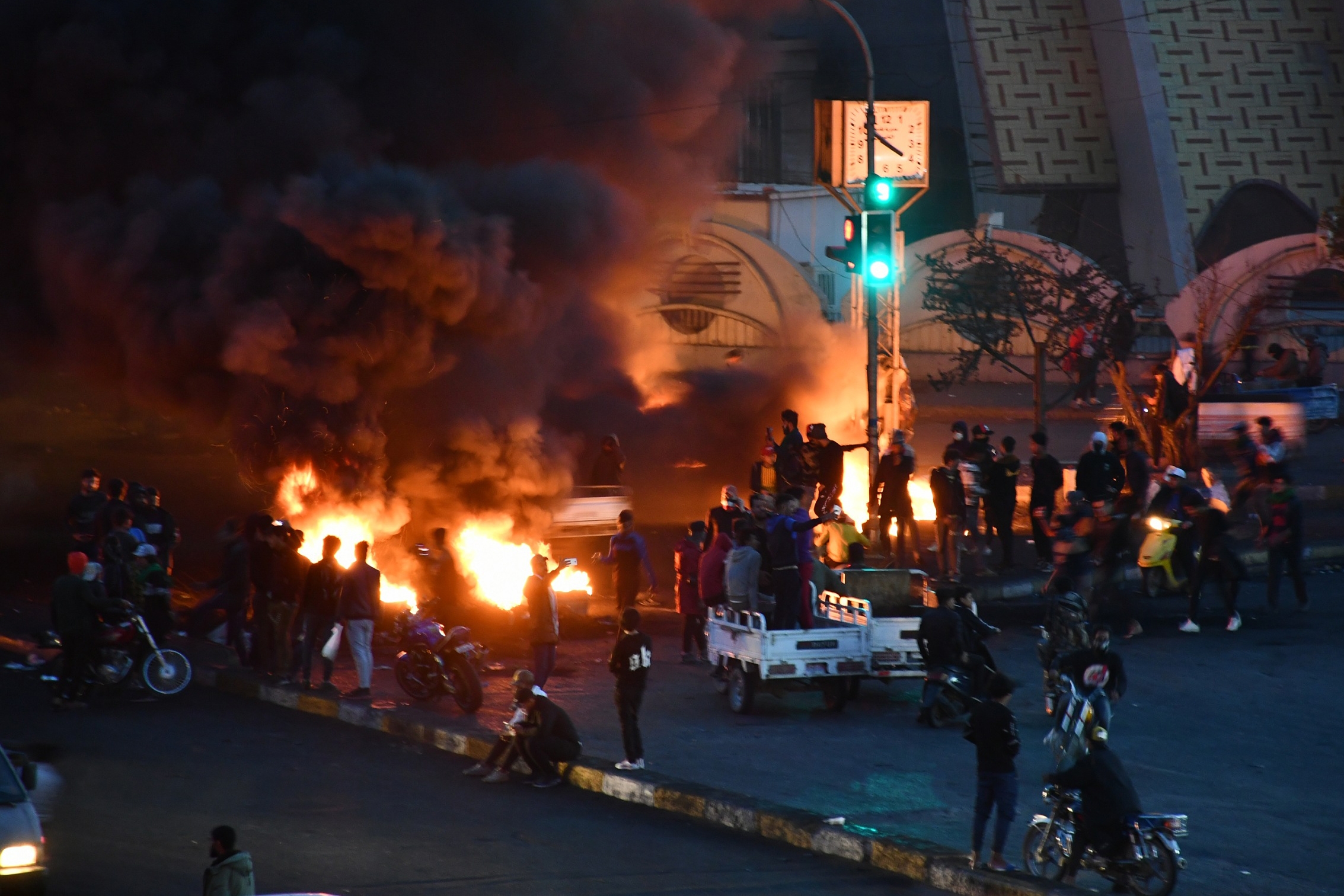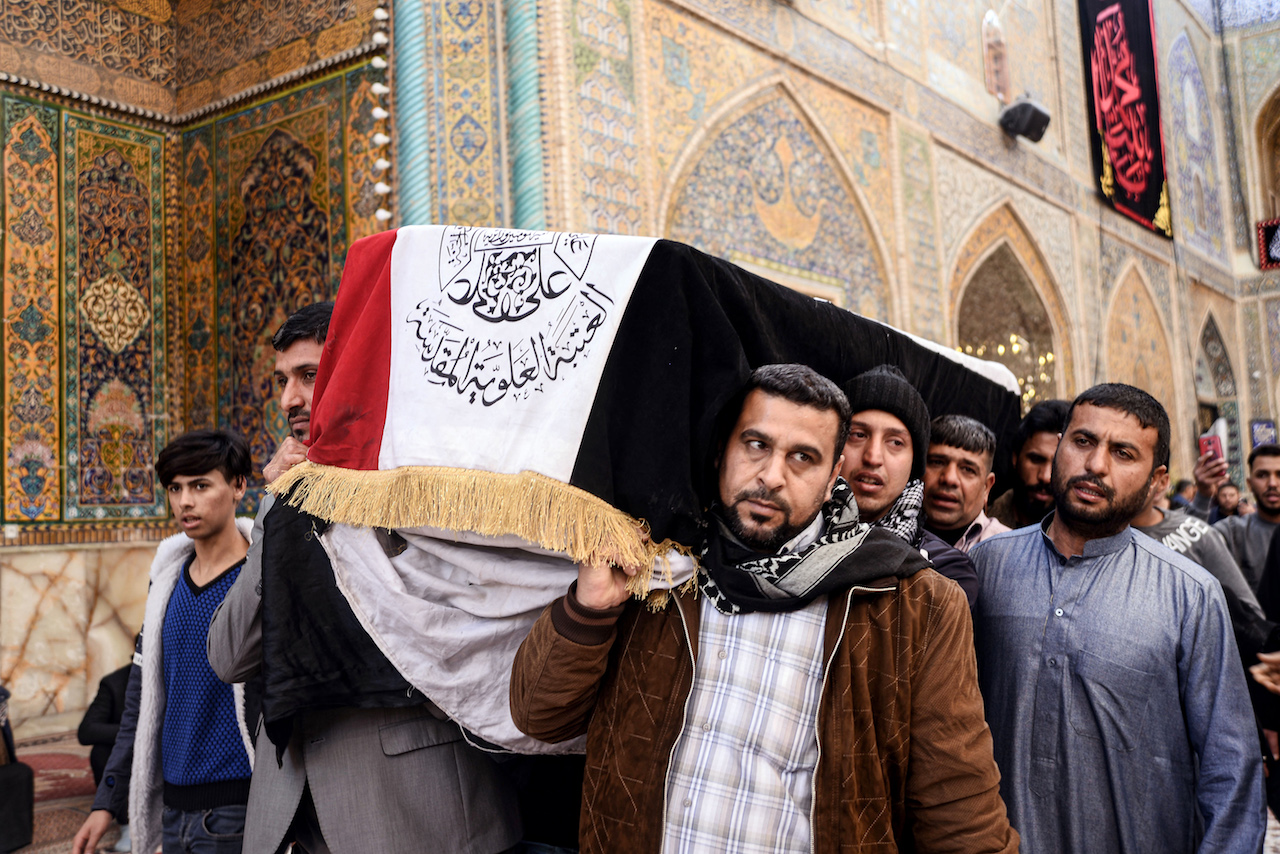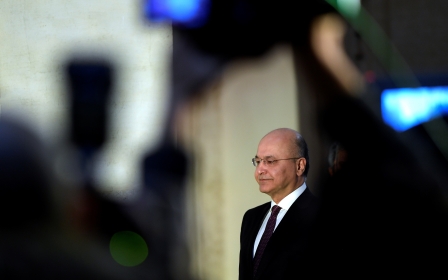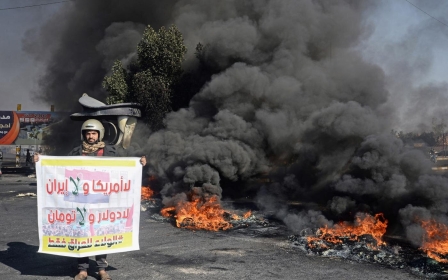Dhi Qar: The southern province at the heart of Iraq's uprising

On Sunday evening Sheikh Adel al-Assad, the head of the Abada tribe, one of the biggest tribes in Nasiriyah, capital of Iraq's southern Dhi Qar province, was in a meeting in the town of Battha’a, north of the city, with the heads of the al-Boddor tribe, another of the biggest tribes in the region.
They were discussing the latest developments in an almost four-month-long anti-government protest movement, when Assad received a phone call from Sheikh Hussein al-Khayoon, the head of the Abooda tribe, asking him to immediately come back to the city.
“The situation is getting worse and the protesters have arrived at the police directorate,” Khayoon said
He said they were planning to attack the police.
“Come pull the youth [the protestors] back. Our sons will be killed,” Khayoon said.
New MEE newsletter: Jerusalem Dispatch
Sign up to get the latest insights and analysis on Israel-Palestine, alongside Turkey Unpacked and other MEE newsletters
According to tribal leaders, the local police commander Brigadier Nasser al-Asadi had offered to secure the demonstrators in the city centre, not to force them to open internal bridges, and ensure that no one would attack them as long as they remained away from the Basra-Baghdad highway, which they had been blockading.
The protesters agreed to return to their old squares in the city centre and set up their tents there on Saturday. Only a few hours passed, when an unknown armed force attacked the demonstrators, killing one of them and wounding several others.
The police commander denied that he and his forces had anything to do with the attack, but fearing violence could erupt again, he asked the heads of tribes to intervene to hold a truce between his forces and the demonstrators.
Assad and his companions rushed to the police directorate where demonstrators were besieging the building and persuaded them to withdraw, but before they moved too far back, they were surprised by gunfire targeting their cars.
The incident did not cause any casualties, but a number of bullets hit Assad’s car. The situation in Nasiriyah was relatively calm, but quickly erupted again when an unknown armed force using government pickup vehicles attacked the protesters in the city centre before midnight, opening fire on them and burning their tents, leaving one protestor dead.
Before the end of the attack, there were rumours everywhere accusing followers of Shia cleric Muqtada al-Sadr of attacking the demonstrators in retaliation for insulting Sadr in their songs, but the local authorities and heads of tribes involved in the negotiations between the police and demonstrators knew that the Sadrists were not involved.
Police sources and a number of tribal sheikhs and activists in Nasiriyah told Middle East Eye that the attack was carried out by a force linked to a prominent leader of an Iran-backed armed faction who occupies a senior local security position, “with the aim of urging protesters and Sadrists to fight each other”.
“We will not fight our brothers [Sadrists], no worries,” Mahmoud, a 30-year-old engineer who has been participating in the demonstrations in Nasiriyah for the last four months, told MEE.
“We know what they [political forces] are planning to do, so do not worry, we will not raise our arms in the face of our brothers.
“Officials, politicians and their gangs, they should be careful and think about what we can do [take up arms], but have not done it [fighting them] yet.
“This is Nasiriyah, not Baghdad.”
The activists in Dhi Qar province and its capital Nasiriyah have become, according to activists and security officials, the “icons of sacrifice” for Iraq’s anti-government protest movement, driving forward the demonstrations and suffering the highest death toll of any city outside Baghdad.
There are fears that the continuing repression, combined with a failure by the government to implement the demanded reforms, could see civil conflict erupt in the province - which would provide the impetus for a harsh crackdown.
“The Iraqi government and its allies are facing a real problem regarding the situation in Nasiriyah, especially as it has been leading the demonstrations throughout Iraq,” political analyst Rahman al-Jebouri, a US university fellow in Iraq’s Sulaymaniyah, told MEE.
“They cannot accuse the demonstrators there of being Baathists or that they implement external agendas as they do with the Baghdad demonstrators to justify their suppression.
“Also, the fact that the tribes backed the demonstrators and the absence of political conflicts between the demonstrators, makes the situation even more difficult, so they started pressuring them [the demonstrators]to push them to take up arms, once against the police, others against the Sadrists.
“Getting the protesters to take up arms will be the best way to finish them off without any consequences."
A hub for rebellion
Dhi Qar, which is located on the left bank of the Euphrates River and its capital, Nasiriyah, about 400km south of Baghdad, is the cradle of ancient Sumerian civilization. It is also thought to be the birthplace of Abraham, patriarch of Judaism, Islam and Christianity.
The province is known for its rebellious nature and has been an incubator for many of the country's political movements, including the Communist Party in the 1930s, and the Baath Party in the 1950s.
It later became a hub for Shia armed groups challenging the rule of former president Saddam Hussein and its marshes were used as sanctuaries for these groups after they carried out attacks.
The 1991 Shia uprising, eventually brutally repressed by Saddam, also began in Dhi Qar.
Since October, the Iraqi government and its Iranian-backed allies have led a bloody crackdown against demonstrators, killing more than 600 and wounding about 25,000 others, according to human rights groups.
Despite the killing of more than 150 demonstrators, most of them in Baghdad, with live bullets and tear gas canisters in the first week, the response of Nasiriyah was the most violent. The demonstrators burned the majority of government and party headquarters and the homes of officials in the province.
"The demonstrator in Dhi Qar in general, and Nasiriyah in particular, is the hardest and fiercest compared with the demonstrators in the rest of the provinces, because the tribal environment focuses on masculine concepts and develops the ego of the young men over time,” Ali Wajih, a prominent human rights advocate told MEE.
'Their challenging of repression with such courage and toughness has turned Nasiriyah into an engine for protests in Baghdad
- Ali Wajieh, human rights activist
“Their challenging of repression with such courage and toughness has turned Nasiriyah into an engine for protests in Baghdad and the provinces, even though they [the protests] did not start from there."
In addition to blocking the bridges, they shut down government departments, schools and universities and declared an open sit-in.
In November, tensions reached new heights and it seemed as though armed conflict could be on the cards.
On 28 November, without prior warning, security forces attacked demonstrators protesting at al-Zaytoon bridge, in the city centre, killing 32 of them and wounding 225 others.
The massacre committed by the Iraqi forces led by General Jamil al-Shammari, the former commander of the crisis unit in Nasiriya, was in cold blood and without clear justifications, provoking an angry reaction internationally and locally.
The heads of a number of Dhi Qar tribes threatened to take up arms against the local authorities in retaliation for the death of their sons.
Iraqi Prime Minister Adel Abdul Mahdi dismissed al-Shammari in an attempt to calm the situation.
The supreme religious authority in Najaf represented by Ayatollah Ali al-Sistani, the most influential cleric in Iraq, in a Friday sermon called on parliament to withdraw confidence from Abdul Mahdi the next day to prevent Iraq "sliding into violence and chaos".
Abdul Mahdi responded by announcing his resignation hours later.
The demonstrators of Nasiriyah did not leave their places and brought their slain comrades to the demonstration grounds, to commemorate them before they were buried.
A ‘blatant challenge’
The demonstrators of Nasiriyah announced their intention on 13 January to implement a new strategy, blocking the highway linking Basra with Baghdad and preventing the arrival of oil and cargo tankers from Basra to the rest of the provinces, if the government and political forces did not respond to the protestors’ demands within just a week.
Demonstrators in Baghdad, who have suffered the worst reprisals from the security forces, retreated a few steps, leaving the leadership of the demonstrations to the protesters of Nasiriyah.
Forty-eight hours later, they announced their "full support for the Nasiriyah demonstrators' initiative".
"As an appreciation for the great and inspiring positions of Nasiriyah, since the beginning of the protests ... and in fulfilment of the pure blood that was shed for the sake of the homeland, the blood of the freemen of Iraq that fell in Dhi Qar and all the uprising cities," read a statement issued on 15 January by Baghdad’s demonstrators.
'The use of violence against the demonstrators of Nasiriyah increases their intransigence and provokes their tribes'
- Security official
Demonstrators in other provinces joined Baghdad protesters, in declaring their support for the initiative and their participation in implementing the idea.
As soon as the deadline expired on 19 January, provincial protesters began blocking the main roads linking their cities with the rest of the governorates, while the Nasiriyah protesters set up their tents near Fahd bridge, north of the city, which connects to the city highway and prevented any oil tankers and goods from passing through.
The recent developments have worried the ruling political forces, who were betting on time and intimidation to quell the demonstrations in Baghdad.
"Corrupt political forces and the government have not been affected by the blocking of the highway and they do not care that the arrival of goods or oil derivatives is being delayed even if the interruption continues for weeks,” a senior political leader told MEE.
"It's all about media. It was a blatant challenge to the state and affects its prestige."
Muqtada al-Sadr, who has millions of followers and controls one of the largest armed factions in addition to a parliamentary bloc of more than 50 members, had volunteered to provide protection for protesters over recent months.
However, following a lukewarm response to his calls for a demonstration against US troops in Iraq, Sadr abruptly U-turned, withdrawing his support for the demonstrators and most of his followers left the demonstration squares throughout Iraq, in response.
According to a number of security and political leaders Abdul Mahdi’s government and his allies considered Sadr’s withdrawal “a green light to attack the demonstrators”.
Hours later, most of the protest grounds in all provinces were severely attacked, particularly the sit-in square near Fahd bridge north of Nasiriyah, resulting in the security forces regaining control of the highway.
Four protesters in Nasiriyah were killed and a further 28 wounded, police and medical sources told MEE.
The protesters of Nasiriyah spent the night in the open for fear of arrests which had affected dozens of them. Before they returned to their homes, Alaa al-Rikabi - a prominent demonstration organiser in Nasiriyah - launched a new initiative this time inviting all the demonstrators of the rising provinces to join the protesters of the city.
They called for a march on foot to Baghdad and to besiege the Green Zone that houses government buildings, to force the Federal Court and the Supreme Judicial Council to intervene and implement the demands of the protesters.
The new al-Rikabi initiative, which set a deadline of mid-February, was welcomed by activists and while concern remained about the vacuum left by the Sadrists in the demonstration squares, especially in Baghdad, tens of thousands of students and families joined the protesters.
This gave a great impetus to the demonstrations, and “sabotaged the government and its allies’ plans to exploit the absence of the Sadrists to finish off the demonstrators,” the prominent political leader said.
‘Most dangerous’ tactic
The incident over the weekend could mark a turning point in Iraq’s protest movement. Despite Sadr's call for his supporters to return to the demonstration areas, especially in Baghdad on Friday, new attempts are being made to sow division in the heartland of the movement because the protesters believe that Sadr is manipulating them and using the demonstrations to serve his political goals.
It is “the most dangerous” tactic their opponents have used so far and may lead to the outbreak of inter-Shia fighting - which all Iraqi sides have worked to avoid up to this point - Iraqi security officials and heads of tribes told MEE.
Pressuring the demonstrators of Nasiriyah by creating disputes between them and the Sadrists on the one hand, and between them and the local authorities on the other, could have dire results.
“The use of violence against the demonstrators of Nasiriyah increases their intransigence and provokes their tribes,” a senior Iraqi National Security official told MEE.
“Tribes in the south have a huge arsenal of weapons, and if pressure continues on their sons in this way, they will seek revenge against the tribes of officials, politicians, and leaders of the armed factions loyal to the government.
“I would not be surprised if I heard that Nasiriyah has declared armed struggle against the government and its allies.”
Middle East Eye delivers independent and unrivalled coverage and analysis of the Middle East, North Africa and beyond. To learn more about republishing this content and the associated fees, please fill out this form. More about MEE can be found here.







